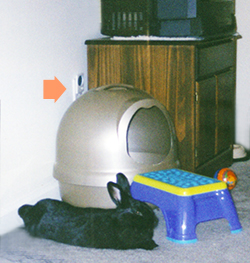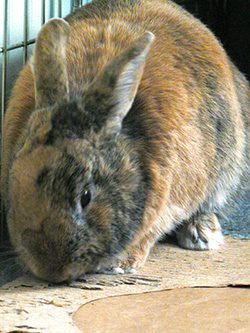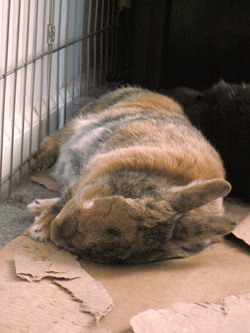
Outlet with nightlight plugged into the top, bottom hidden by litter box ... cords behind the TV stand, all bunny safe now!
There are two goals in bunny proofing: protecting your rabbit in the space and protecting your space from the rabbit. Last week I wrote about basic bunnyproofing. This post deals with a very specific area of bunnyproofing, protecting your cords and cables. I don’t know why rabbits love cords so much. They don’t look tasty to me, but rabbits just love to chew cords.
Look at any area your rabbit will roam in freely and locate all the cords: electric, TV cable, telephone, and electronic or computer. If a rabbit chews through a live electric cord, there is a danger to the rabbit of burns or electrocution and a danger to your home if a short sparks a fire. Even if no one is harmed, you will be aggravated, inconvenienced, and out some money for repairs or replacements. You also might be embarrassed having to explain to a repairman or utility company just why your cord or cable needs replacing.
One of the best protections for cords is to place them behind large pieces of furniture where the rabbit cannot fit to get access. However, if the outlets are under windows or on a wall above furnace or air conditioning vents, you may not want to place large furniture pieces there. In that case, you will have to protect the cords and outlets.
You need to decide whether you want something flexible and movable, or something that will permanently attach to the wall. Also, will you be covering cords individually, or trying to cover several cords together? Note that electric power cables and data or telephone cables should not be enclosed together. Data or telephone cables are sensitive to interference from electric power.
Cord Covers: Split loom is a continuous flexible tube that is split along the entire length. We currently double protect exposed cords by using two different sizes of split loom to form two layers. We use a smaller diameter of split loom for the inner layer and then make sure the split on the larger outer layer is on the opposite side, making getting to the cord a real challenge for our rabbits (they haven’t). Click to see split loom examples on Amazon.com.
Cable Race: For the décor conscious bunny owner, this is a permanent and professional installation. It is available in either adhesive-back or screw mount. There are color choices. Some can be painted to match the wall color. There is a plastic trough that snaps shut, completely covering one or more cables. For bunny proofing, it may be used in combination with one of the flexible materials. It is generally available only from electrical or electronic suppliers, but you can see what one example looks like here on Amazon.com.
Outlet Plugs: Outlet plugs are the simple plastic plugs that fit into unused outlets and are widely available for child proofing. Example on Amazon.com.
Outlet Covers: These are typically meant to keep babies away from plugs and outlets. They cover the whole outlet protecting the plugs from being knocked or pulled out and you can run a cord protected with plastic split loom right into the outlet cover. Some rabbits have cleverly realized that the point where a cord cover and plug meet is vulnerable. Covering the whole outlet removes access to that vulnerable spot. Here are three examples on Amazon.com: Safety 1st, Safety 1st, Kidco.
Send your rabbit a clear message that cords and cables are not on their menu of available chew toys.




